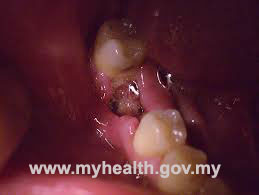Introduction
Smoking tobacco among the male and female has been in an increasing trend in our country. Smoking harms almost all internal organs in our body. Smoking is also associated with coronary heart disease artherosclerosis, respiratory disease and various carcinomas.
Besides that smoke from tobacco has a detrimental effect on the healing process of oral tissues after an oral surgical procedure. Content of tobacco smoke such as nicotine, cotinine, carbon monoxide and hydrogen cyanide are cytotoxic towards cells that are involved in oral tissue healing.
Types of complications that can arise due to smoking that affects oral surgical healing are as follows:
- Dry socket
Fibrinolytic activity caused by smoking reduces blood supply at the surgical site after dental extractions which results in disrupted wound healing. This will lead to dry socket which was found common among smokers. The toxic content of cigarette will prevent formation of blood clot inside the socket, thus impair wound healing process. Smoking after dental surgical extractions seemed to increase the susceptibility to dry socket formation.

Dry socket formation due to smoking - Implant failure
Studies had shown that smoking strongly related to implant failure. Compromised peri-implant soft tissue health and peri-implant bone loss among the smokers’ leads to high implant failure rate.

Implant failure due to peri-implant bone loss and compromised soft tissue healing - Delayed bone healing following maxillofacial trauma
Nicotine has a negative effect on bone healing by diminishing osteoblast function. Smoking after surgical procedure of open reduction and internal fixation of facial bone fractures will lead to plates and screws exposure due to compromised soft tissue and hard tissue healing. Surgical site infection is also common in smokers who had undergone oral surgical procedures due to trauma. Apart from delayed healing, smokers are at a great risk to undergo the operation under general anaesthesia as they are susceptible to anaesthetic risks.

Plate and screws exposure due to smoking following internal fixation - Failure of periodontal treatment
Failure of periodontal treatment is strongly related to smoking habit. Smoking after periodontal treatment may contribute to 50% chance of treatment failure rate compared to non smokers. Periodontal treatments that could be affected are:
- Deep scaling – calculus removed from root surfaces deep inside periodontal pocket.
- Bone grafting – patients own bone or synthetic bone placed at bone loss area.
- Guided tissue regeneration – membrane placed in between soft tissue and bone to promote periodontal tissue growth
Advise for smokers who will be undergoing oral surgical procedures.
In general, smoking harms the whole body. Thus, smoking cessation is needed for all smokers undergoing oral surgical procedures. To avoid general anaesthesia complications, smokers are advised to stop smoking three weeks prior to oral surgical procedures under general anaesthesia. Avoid smoking at least for one week post oral surgical procedures to prevent compromised wound healing.
References
- Balaji SM. Tobacco smoking and surgical healing of oral tissues: A review. Indian J Dent Res 2008;19:344-8
- Burns JL, Mancoll JS, Phillips SG. Impairments of wound healing. Clin plastic surg 2003;30: 47-56
- Hollinger JO, Schmitt JM, Hwang K, Soleymani P, Buck D. Impact of nicotine on bone healing. J Biomed Mater Res 1999;45:294-301
- Grossi SG, zambon J, Machtei EE, Schifferie R, Andreana S, Genco RJ,et al. Effects of smoking and smoking cessation on healing after mechanical periodontal therapy. J Am Dent Assoc 1997;128:599-607
- Levin L, Schwartz-Arad D. The effect of cigarette smoking on dental implants and related surgery. Implat Dent 2005;14:357-61
| Last Reviewed | : | 11 May 2015 |
| Writer / Translator | : | Dr. Vimahl Dass a/l Paramanandam |
| Accreditor | : | Dr. Ravindran a/l Murugesan |







